- Choose the Right Location
- Sunlight
- Soil Drainage
- Soil pH
- Protection from Strong Winds
- Avoid Areas with Tree Roots
- Prepare the Soil
- Select the Right Varieties
- Consider Climate and Hardiness Zones
- Think about Bloom Time
- Consider Color and Shape
- Consider Height
- Do Your Research
- Planting Time
- Choosing the Right Spot
- Preparing the Soil
- Planting Depth
- Planting Depth
- Spacing
- Watering and Maintenance
- Harvesting and Storing
- 1. Harvesting
- 2. Drying
- 3. Cleaning
- 4. Storing
- 5. Replanting
- Questions and Answers:
- What is the best time to plant tulip bulbs?
- Can I plant tulip bulbs in the spring?
- How deep should I plant tulip bulbs?
- Do tulips need sunlight?
- Can I leave tulip bulbs in the ground year-round?
- How often should I water tulip bulbs?
- Videos: TULIPS 101: GROWING TULIPS FOR BEGINNERS
Are you planning to add some color and beauty to your garden this spring? Look no further than tulips! These vibrant and elegant flowers are a favorite among gardeners for their wide range of colors and their ability to thrive in various climates.
Planting tulips may seem like a straightforward task, but there are several key factors that can greatly affect the success of your tulip garden. From choosing the right location to preparing the soil, this planting guide will provide you with tips and tricks to ensure that your tulips bloom to their fullest potential.
Choosing the right location: Tulips require full sun to thrive, so it’s important to choose a location that receives at least six hours of direct sunlight each day. Additionally, tulips prefer well-draining soil, so avoid areas that are prone to waterlogging.
Preparing the soil: Before planting your tulip bulbs, you’ll need to prepare the soil. Start by removing any weeds or debris from the planting area. Then, loosen the soil to a depth of around 12 inches using a garden fork or shovel. This will help improve drainage and allow the tulip bulbs to establish their root system more easily.
Planting the bulbs: Tulips should be planted in the fall, ideally six weeks before the first frost. Dig a hole that’s about three times the height of the bulb and place the bulb in the hole with the pointed end facing up. Cover the bulb with soil, gently firming it around the bulb to remove any air pockets.
Tip: To achieve the best visual impact, consider planting tulips in clusters or rows rather than single bulbs. This will create a more dramatic display of color.
Caring for your tulips: After planting your tulip bulbs, it’s important to provide them with proper care to ensure their healthy growth. Water the bulbs thoroughly after planting, and continue to water them throughout the fall season until the ground freezes. Once the leaves emerge in the spring, water them regularly, but avoid overwatering as this can cause the bulbs to rot.
By following these tips and tricks, you’ll be well on your way to a successful tulip garden that will delight you with its beauty year after year. So, grab your gardening tools and get ready to plant some tulips!
Choose the Right Location
The success of your tulip planting greatly depends on choosing the right location. Here are some important factors to consider when selecting a spot for your tulips:
Sunlight
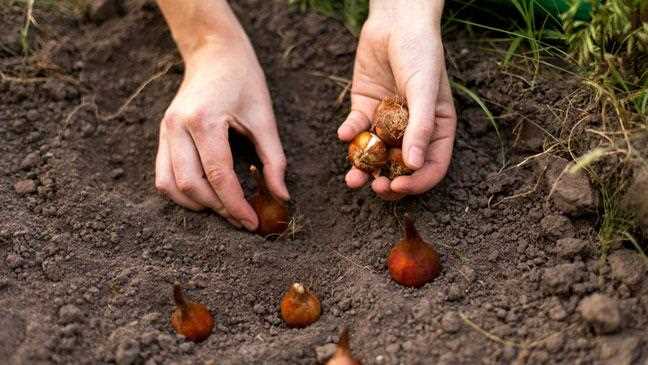
Tulips require at least 6 hours of direct sunlight each day to thrive. Choose a location that receives ample sunlight, preferably in the morning and early afternoon.
Soil Drainage
Tulips prefer well-draining soil to avoid excessive moisture. Avoid planting them in areas with poor drainage or where water tends to accumulate. Heavy, clay-like soil can be improved by adding organic matter such as compost or well-rotted manure.
Soil pH
Tulips generally prefer slightly acidic to neutral soil pH levels ranging from 6.0 to 7.0. Test your soil’s pH level using a soil testing kit and adjust it if necessary by adding lime to increase pH or sulfur to decrease pH.
Protection from Strong Winds
Tulip flowers are delicate and can easily be damaged by strong winds. If possible, choose a location that is sheltered from strong winds, such as near a tall fence or building.
Avoid Areas with Tree Roots
Tulips do not compete well with tree roots for nutrients and water. Avoid planting them near trees or large shrubs where their growth may be hindered.
By choosing the right location for your tulips, you can ensure their successful growth and vibrant blooms. Taking these factors into consideration will help create optimal conditions for your tulips to thrive.
Prepare the Soil
Before planting your tulip bulbs, it’s important to prepare the soil to provide a fertile and well-draining environment for the plants to thrive. Follow these steps to ensure the best conditions for your tulips:
- Choose a sunny location: Tulips require at least six hours of direct sunlight each day to grow and bloom successfully. Select a spot in your garden that receives ample sunlight throughout the day.
- Clear the area: Remove any weeds, grass, or other vegetation from the planting area. Tulips do not compete well with other plants for nutrients and space, so it’s crucial to create a clean planting bed.
- Loosen the soil: Use a garden fork or a tiller to loosen the soil in the planting area. This will improve drainage and help the tulip bulbs establish roots more easily. Loosen the soil to a depth of at least 12 inches.
- Amend the soil: If your soil is heavy clay or sandy, you may need to add organic matter such as compost, well-rotted manure, or peat moss to improve its texture and fertility. Mix the organic matter into the loosened soil thoroughly.
- Test the soil pH: Tulips prefer a slightly acidic to neutral pH range of 6.0 to 7.0. Use a soil testing kit to determine the pH of your soil. If necessary, make adjustments by adding lime to raise the pH or sulfur to lower it.
- Remove rocks and debris: Remove any rocks, roots, or other debris from the soil. These can hinder root growth and cause damage to the bulbs.
By following these steps to prepare the soil, you will create an optimal growing environment for your tulip bulbs. This will help ensure their success and enhance the beauty of your garden. Happy planting!
Select the Right Varieties
When it comes to planting tulips, selecting the right varieties can make a big difference in the success of your garden. Here are some tips to help you choose the best tulip varieties for your planting needs:
Consider Climate and Hardiness Zones
Before selecting tulip varieties, it’s important to consider your climate and hardiness zone. Tulips are classified into different hardiness zones, which indicate their ability to tolerate cold temperatures. Make sure to choose varieties that are suitable for your specific zone to ensure they will thrive in your garden.
Think about Bloom Time
Tulips come in a wide range of bloom times, from early spring to late spring. Consider when you want your tulips to bloom and choose varieties accordingly. If you want to have a long season of tulip blooms, you can select a mix of early, mid, and late blooming varieties.
Consider Color and Shape
Tulips come in a variety of colors and shapes, including single, double, fringed, and parrot tulips. Think about the overall aesthetic you want to achieve in your garden and choose tulip varieties that will complement your desired color scheme and flower shape.
Consider Height
Tulips vary in height, ranging from short varieties around 6-8 inches to taller varieties around 22-28 inches. Consider the location where you plan to plant the tulips and choose varieties that will be proportionate to the space and other plants around them.
Do Your Research
There are countless tulip varieties available, so it’s worth doing some research to find the best ones for your specific needs. Look for reliable sources, such as gardening websites, books, or local nurseries, that provide detailed information on the different tulip varieties, including their growing habits, care requirements, and recommended planting conditions.
By selecting the right tulip varieties, you can ensure a successful and beautiful tulip garden that will bring joy and color to your outdoor space. Take your time to research and choose the perfect tulip varieties for your garden and enjoy the beauty they will bring when they bloom.
Planting Time
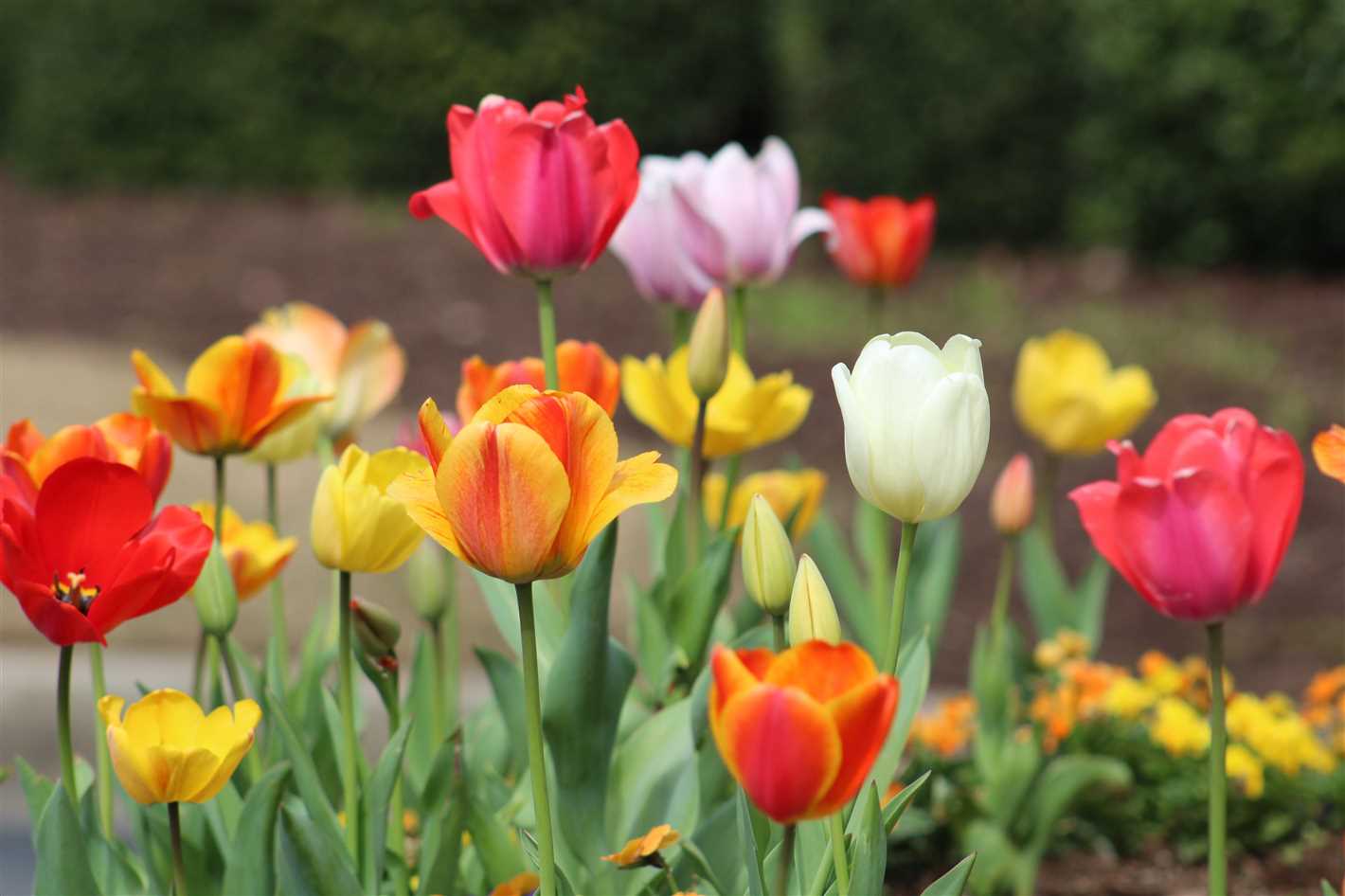
When it comes to planting tulips, timing is crucial. Ideally, you should plant tulip bulbs in the fall, before the ground freezes. This allows the bulbs to establish roots and get ready for winter dormancy. The exact planting time will vary depending on your climate, but a good rule of thumb is to plant tulips about 6 to 8 weeks before the first hard frost is expected in your area.
In most regions, this means planting tulip bulbs in September or October. However, if you live in a warmer climate where the winter temperatures do not reach freezing, you may need to refrigerate the tulip bulbs for a few weeks before planting them in the ground. This cold treatment mimics the winter dormancy that the bulbs would naturally experience in colder climates.
Choosing the Right Spot
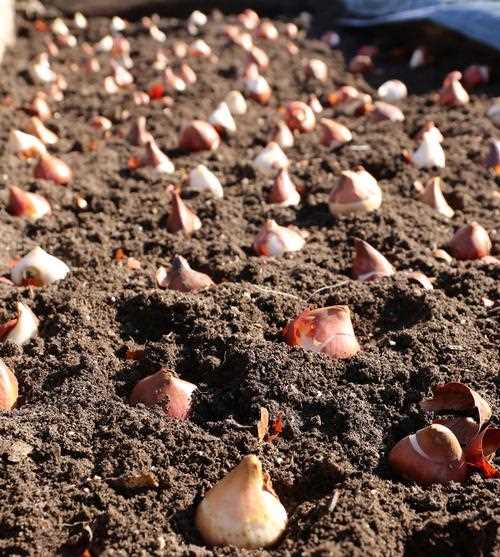
Tulips prefer a sunny location with well-draining soil. Before planting, make sure to choose a spot in your garden that receives full sun for at least 6 hours a day. Avoid areas that are prone to waterlogging, as tulips do not like to sit in wet soil. If your soil is heavy and clayey, consider amending it with organic matter or planting the tulips in raised beds to improve drainage.
Preparing the Soil
Before planting the tulip bulbs, it’s important to prepare the soil properly. Start by removing any weeds or existing vegetation from the planting area. Then, dig the soil to a depth of about 8 inches (20 cm) and break up any clumps. Mix in well-rotted compost or organic matter to improve the soil structure and fertility. This will provide the tulip bulbs with the nutrients they need to grow and bloom.
You can also add a slow-release bulb fertilizer to the soil to give the tulips an extra boost. Follow the manufacturer’s instructions for the appropriate amount to use, and be sure to mix it into the soil evenly.
Planting Depth
The planting depth for tulip bulbs will depend on their size. As a general rule, plant the bulbs about 6 to 8 inches (15 to 20 cm) deep, measuring from the bottom of the bulb. If you are unsure, a good guideline is to plant them at a depth that is 2 to 3 times the height of the bulb.
Make sure to space the bulbs about 4 to 6 inches (10 to 15 cm) apart to allow for proper airflow and growth. Planting them too close together can result in crowded plants and poor flowering.
Planting Depth
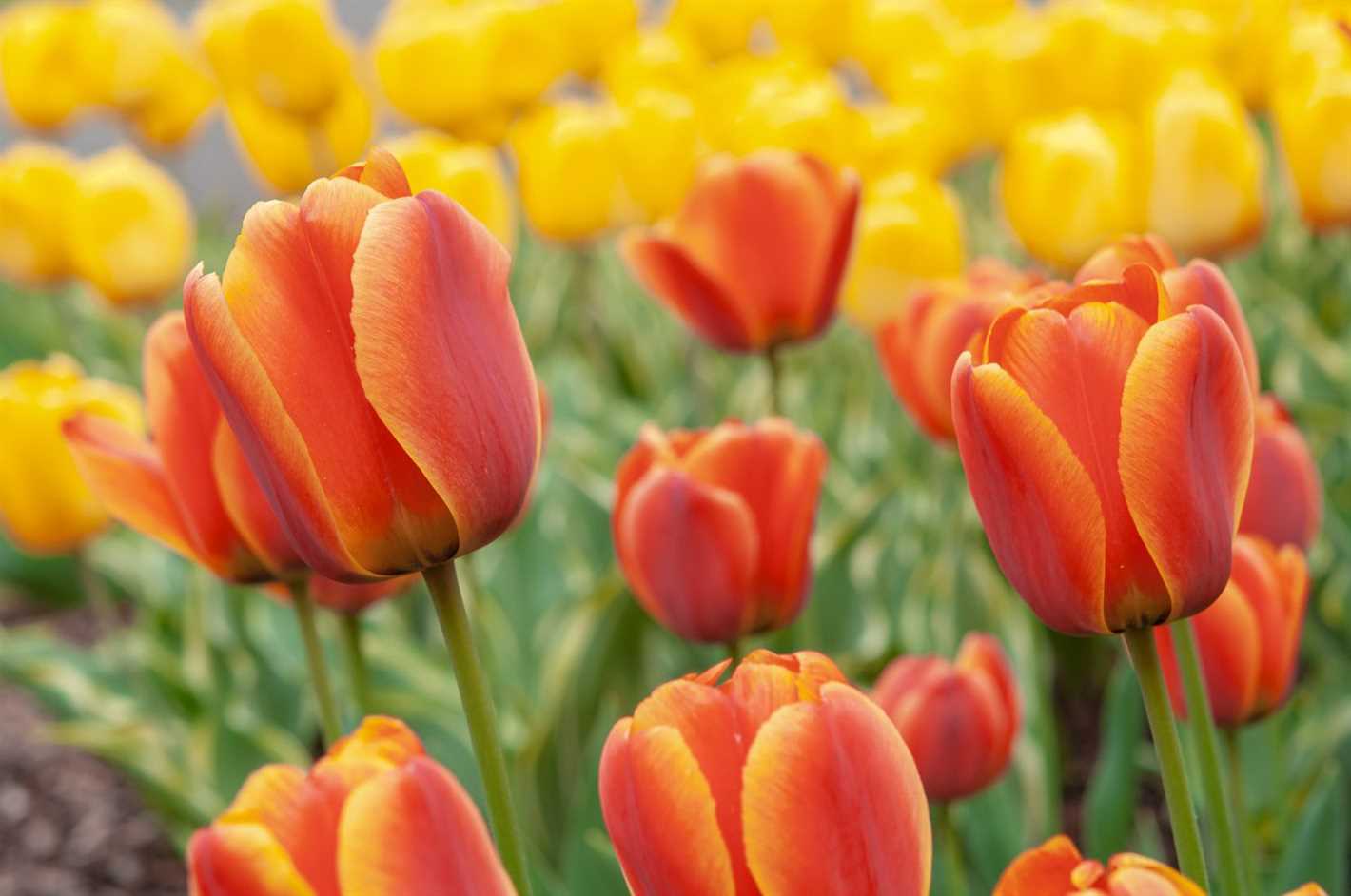
Planting tulips at the correct depth is crucial for their successful growth and blooming. The depth at which you plant your tulip bulbs will depend on the size of the bulb. Here are some general guidelines for planting depth:
- Small tulip bulbs (less than 1 inch in diameter) should be planted 4-6 inches deep.
- Medium-sized tulip bulbs (1-2 inches in diameter) should be planted 6-8 inches deep.
- Large tulip bulbs (more than 2 inches in diameter) should be planted 8-10 inches deep.
Planting bulbs at the correct depth ensures that they have enough insulation to survive cold winters and emerge in the spring. It also helps prevent them from rotting or drying out.
When planting tulip bulbs, dig a hole in the soil that is deep enough to accommodate the bulb. Place the bulb in the hole pointy side up, and cover it with soil. Make sure the soil is firm but not compacted.
Spacing between tulip bulbs is also important. Plant bulbs at least 4-6 inches apart to allow for proper air circulation and prevent overcrowding.
By following these guidelines for planting tulips at the correct depth, you can help ensure that your tulips thrive and provide a beautiful display of color in your garden.
Spacing
Proper spacing is essential when planting tulips to ensure that they have enough room to grow and thrive. Here are some tips for spacing your tulip bulbs:
- Plant bulbs approximately 4 to 6 inches apart.
- Space rows of bulbs approximately 6 to 8 inches apart.
- If planting in containers, space bulbs based on the size of the container. As a general rule, use bulbs that are approximately one bulb width apart.
- When planting multiple rows of bulbs, stagger the rows to create a natural and full look.
Spacing your tulip bulbs correctly will allow them to have enough access to sunlight, water, and nutrients, promoting healthy growth and abundant blooms.
Additionally, proper spacing will prevent overcrowding, which can lead to disease and poor air circulation.
In case you are unsure about the spacing, it is always a good idea to consult the specific instructions provided by the tulip bulb supplier or refer to a reliable planting guide.
Watering and Maintenance
Proper watering and maintenance are essential for the success of your tulip planting. Follow these tips to ensure healthy and beautiful tulips:
- Watering: Tulips require regular watering, particularly during their active growth period. Water deeply, ensuring the soil is evenly moist but not waterlogged. Avoid overwatering, as it can lead to bulb rot.
- Timing: Water your tulips immediately after planting to settle the soil around the bulbs. After that, continue to water them regularly throughout the growing season.
- Frequency: Aim to water your tulips about once a week, providing enough water to penetrate the ground and reach the roots. Adjust the frequency depending on weather conditions, such as rainfall.
- Maintenance: In addition to watering, there are a few other maintenance tasks to keep in mind:
- Deadheading: Remove faded flowers to prevent the plant from putting energy into seed production. This encourages the tulip to focus on bulb development.
- Foliage care: Allow the foliage to die back naturally after flowering. This process helps the bulbs store energy for the next blooming season. Avoid cutting or removing the foliage until it turns yellow and withers.
- Weeding: Regularly remove weeds and any competing plants around your tulips to reduce competition for nutrients and water.
By following these watering and maintenance guidelines, you can ensure that your tulips thrive and provide you with vibrant blooms year after year.
Harvesting and Storing
Once your tulips have bloomed and the flowers begin to fade, it’s time to harvest them for indoor arrangements or storage. Here are some tips for harvesting and storing your tulip bulbs:
1. Harvesting
- Cut the tulip stems as close to the ground as possible, using clean and sharp gardening shears.
- Make sure to leave the foliage intact to allow the bulb to continue gathering energy for next year’s growth.
- Avoid pulling the tulips out of the ground, as this can damage the bulbs.
2. Drying
After harvesting, gently remove any excess soil from the bulbs and lay them out in a cool, dry, and well-ventilated area. Allow the bulbs to dry for about a week. This drying period helps to prevent rot and fungal diseases.
3. Cleaning
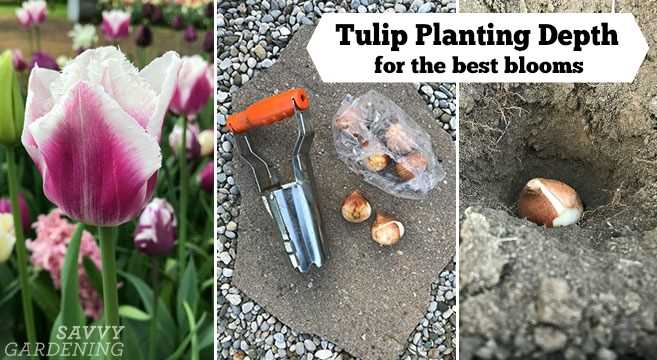
Once the bulbs are dry, gently remove any remaining foliage or roots. Avoid removing the brown protective tunic that covers the bulb, as this helps to keep the bulb healthy during storage.
4. Storing
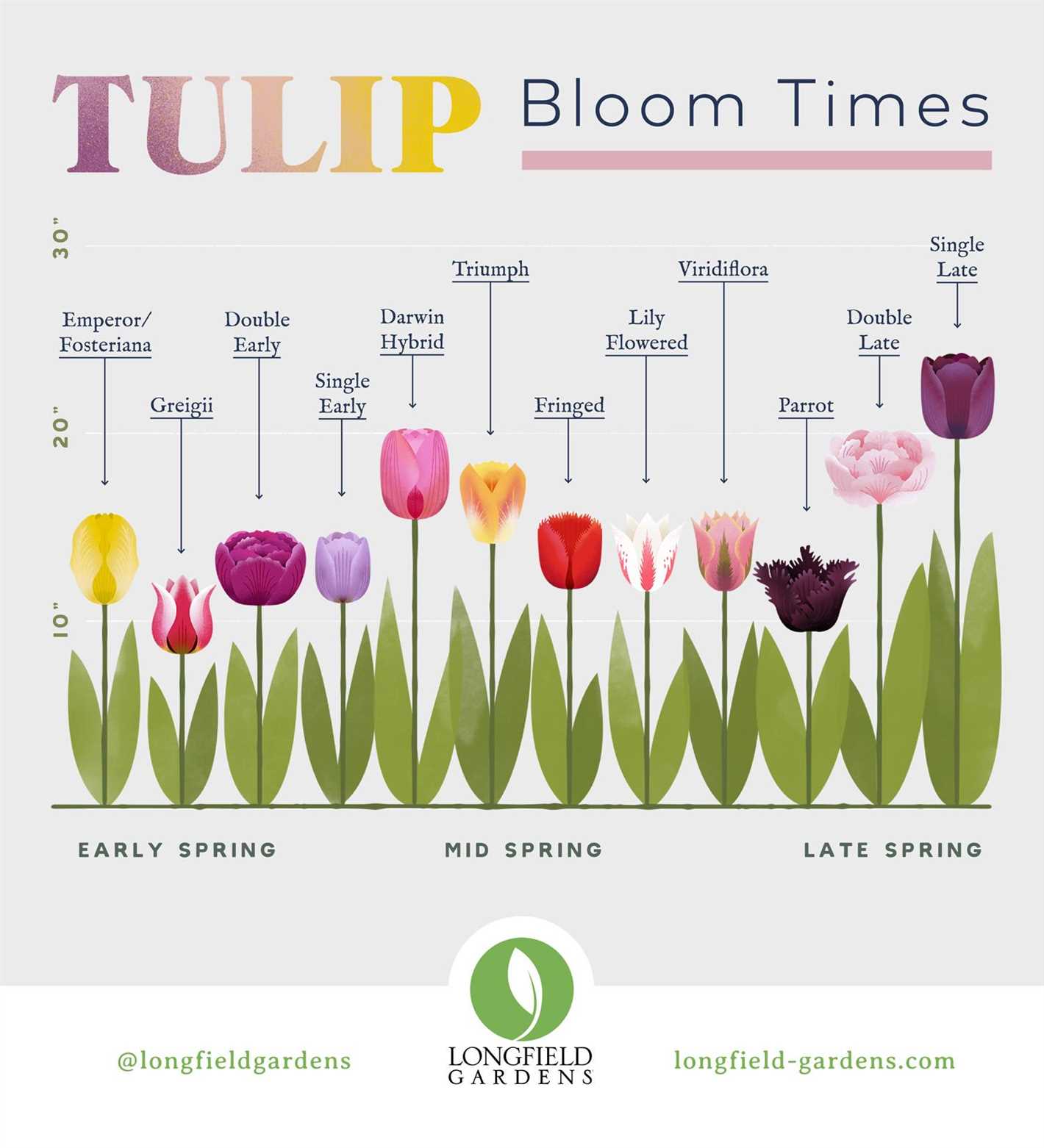
Store the dried and cleaned tulip bulbs in a cool, dark, and dry place. A cardboard box or a mesh bag works well for this purpose. Ensure that the storage area is free from excess moisture and temperature fluctuations.
5. Replanting
In the fall, you can replant the stored tulip bulbs back into your garden. Before planting, inspect the bulbs for any signs of damage or disease. Discard any bulbs that appear soft, mushy, or show signs of rot.
| Tips: |
|---|
| Label your bulbs: To easily identify the tulip varieties, label each variety before storing the bulbs. |
| Keep rodents away: If rodents are a problem in your area, consider storing the bulbs in wire mesh containers to prevent them from being eaten. |
| Inspect for pests: Before storing, inspect the bulbs for any signs of pests such as aphids or mites. You can treat affected bulbs with a mild insecticide before storing them. |
Questions and Answers:
What is the best time to plant tulip bulbs?
The best time to plant tulip bulbs is in the fall, around September to October, before the first frost hits.
Can I plant tulip bulbs in the spring?
Although it is ideal to plant tulip bulbs in the fall, you can still plant them in the spring if you missed the planting window. However, they may not bloom as well or at all.
How deep should I plant tulip bulbs?
You should plant tulip bulbs about 6-8 inches deep, with the pointed end facing upwards.
Do tulips need sunlight?
Yes, tulips need plenty of sunlight to grow and bloom. Make sure to choose a location that gets at least 6 hours of direct sunlight per day.
Can I leave tulip bulbs in the ground year-round?
Tulip bulbs can be left in the ground year-round, but they may not survive extreme cold temperatures. In colder regions, it is recommended to dig up the bulbs after they have finished blooming and store them in a cool, dry place until the next planting season.
How often should I water tulip bulbs?
Tulip bulbs should be watered regularly after planting, especially during dry periods. Keep the soil evenly moist, but avoid overwatering, as this can cause the bulbs to rot.







